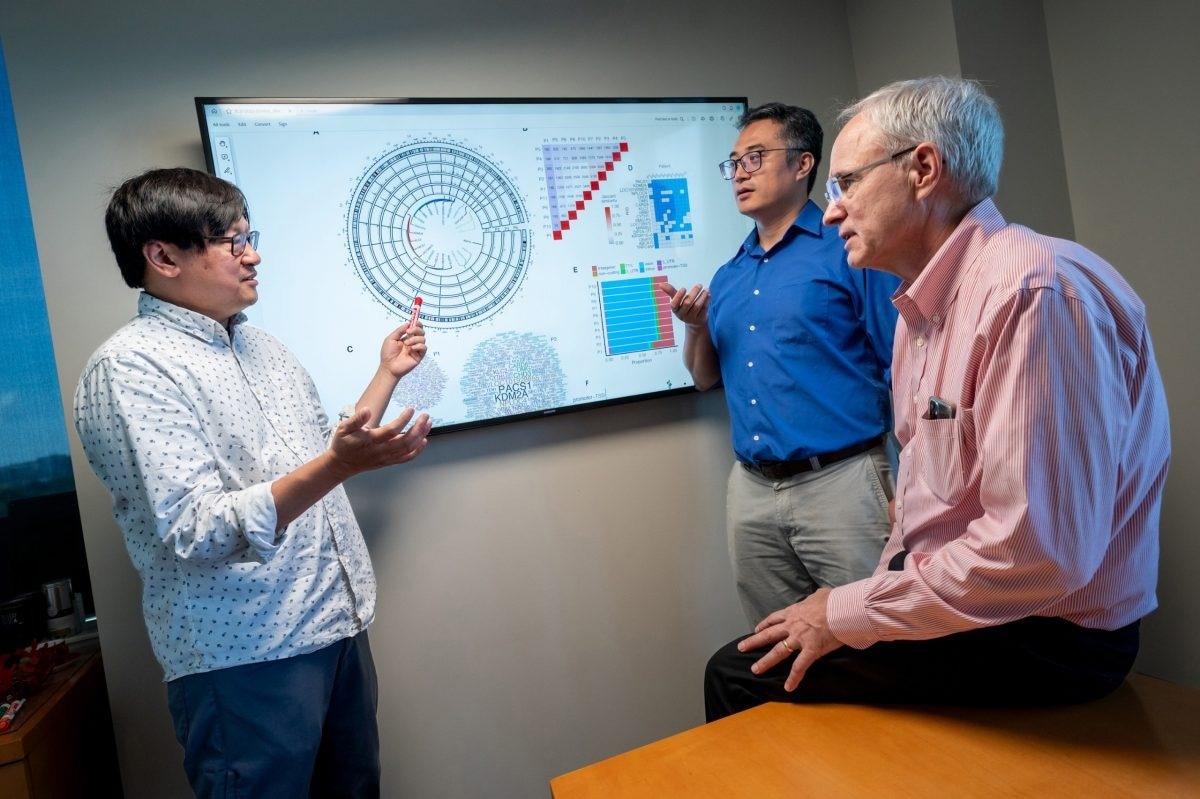Patients with X-linked severe combined immunodeficiency disorder (SCID-X1), often known as “bubble boy disease,” are born with a faulty gene that inhibits immune cells from being produced. In 2019, St. Jude Children’s Research Hospital gene therapy restored the immune system in several newborns with SCID-X1 by delivering copies of the repaired gene. St. Jude scientists have detailed where the gene copies integrate into patient DNA as part of continuous efforts to monitor patient safety, giving a basis for understanding the biology and safety of utilizing lentiviral vectors. The findings were reported in Science Advances.
 (L to R) First author Koon-Kiu Yan, Ph.D., St. Jude Department of Computational Biology, senior co-corresponding author Jiyang Yu, Ph.D., St. Jude Department of Computational Biology interim chair and co-corresponding Stephen Gottschalk, M.D., St. Jude Department of Bone Marrow Transplantation and Cellular Therapy chair. Image Credit: St. Jude Children’s Research Hospital
(L to R) First author Koon-Kiu Yan, Ph.D., St. Jude Department of Computational Biology, senior co-corresponding author Jiyang Yu, Ph.D., St. Jude Department of Computational Biology interim chair and co-corresponding Stephen Gottschalk, M.D., St. Jude Department of Bone Marrow Transplantation and Cellular Therapy chair. Image Credit: St. Jude Children’s Research Hospital
We now have a robust pipeline to monitor the safety of lentiviral gene therapies. This really gives hope to patients with genetic diseases that can be cured by lentiviral gene therapy. It looks like we cured bubble boy disease safely in these patients.”
Jiyang Yu, PhD, Study Senior Co-Corresponding Author and Interim Chair, Department of Computational Biology, St. Jude Children’s Research Hospital
The St. Jude team published the whole computational process alongside the article.
Unlike previous retroviral techniques, the St. Jude lentiviral gene therapy for SCID-X1 appears to be both successful and safe several years after treatment. The researchers determined where the gene was introduced to the patients’ DNA and why the vector integrated there.
Scientists already recognized that lentiviral gene treatments incorporated into various sections of DNA appeared safer than prior methods, but they could not explain why.
3D Genome Structure Holds the Key to SCID-X1 Gene Therapy
The researchers discovered that copies of the new, corrected gene had been introduced into specific genomic regions for the study’s participants. The rationale was deceptively simple: hotspots are places where the lentiviral vector first meets after entering the cell’s nucleus via a channel known as a nuclear pore.
It is like someone coming into a room and taking the first available seat near the door. The room is the nucleus. The seats are these DNA elements right near the door of the nuclear pore. That never occurred to me before this study, but it is a very simple principle in the end.”
Stephen Gottschalk, MD, Chair, Department of Bone Marrow Transplantation & Cellular Therapy, St. Jude Children’s Research Hospital
The St. Jude team discovered that the integration site pattern of gene therapy into patient cells gave insight into the approach’s safety and efficacy.
We performed a comprehensive single-cell multi-omic analysis of this gene therapy to understand whether a functional copy of the corrected gene was in patient cells, to what extent the gene was expressed, and the chromatin organization at a single-cell level. Before this study, we could measure the general gene expression of a bulk group of cells. But with bone marrow samples from two patients, we saw at a single-cell level which genes were expressed in which cell types.”
Koon-Kiu Yan, Study First Author and Computational Biologist, St. Jude Children’s Research Hospital
Yan demonstrated using that single-cell study, in addition to their earlier studies, that integration into compartments close to the nuclear pore is also connected to treatment safety and efficacy. Previous attempts at gene therapy integrated into promoters close to or oncogenes directly, ultimately leading to cancer.
St. Jude’s lentiviral vector carefully avoids promoters without affecting oncogenes, increasing the safety of the therapeutic process. A similar trend was seen when lentiviral gene therapy was employed to produce chimeric antigen receptor (CAR) T cells, indicating that the SCID-X1 vector may not be the only factor in this phenomenon's occurrence.
Yu and Gottschalk added, “The integration pattern data could serve as a map of potentially safe integration sites. The single-cell analysis is like deep cartography, a map with a near pixel-perfect resolution. The large number of integration sites could be used as a safety reference for future lentiviral gene therapies.”
One instance, in particular, stood out: it was discovered that the patient who needed a second dosage of gene therapy to be cured had a distinct integration pattern than the patients who had responded to the first dose.
The patient’s integration pattern mirrored those of the other patients after receiving the second dosage, indicating that the treatment was successful. To better future gene treatments, this study lays a platform for understanding variations in treatment response.
Source:
Journal reference:
Yan, K.-K., et al. (2023). Integrome signatures of lentiviral gene therapy for SCID-X1 patients. Science Advances. doi.org/10.1126/sciadv.adg9959